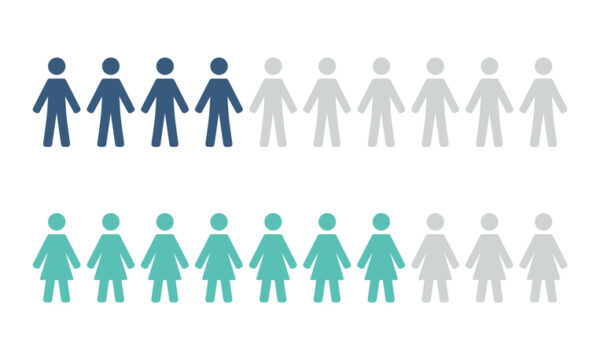
Clinical trial attrition can be detrimental to clinical outcomes, patient well-being and the financial health of research programs. Clinical trial dropout rates, which range from 15% to 40%, greatly impact the trajectory and success of clinical research. With attrition rates already significantly affecting clinical trial outcomes, clinical research organizations and sites must prioritize and investigate ways to decrease patient burden. The reality is that inconveniences placed on trial participants impact patient retention and for this reason, clinical trial organizers and sites need to prioritize simplifying methods of patient involvement.
The obstacles imposed by traditional clinical trial processes, such as the time needed to travel to a research site for regular visits with nurses or principal investigators, are often reduced with decentralized clinical trials (DCTs). However, patients will take on greater responsibilities when participating in decentralized research studies, such as managing and charging devices, using connected medical devices at home or completing questionaries or surveys daily or weekly.

With the Rise of AI, What IP Disputes in Healthcare Are Likely to Emerge?
Munck Wilson Mandala Partner Greg Howison shared his perspective on some of the legal ramifications around AI, IP, connected devices and the data they generate, in response to emailed questions.
With these new responsibilities, there is growing concern that these efforts to reduce the burden of participation by bringing the trial to the patient, the industry has made patient involvement more complex. The clinical trials industry – from technology providers and clinical research organizations (CROs) to sponsors and sites – should approach trial data collection in a way that minimizes patient inconvenience while maximizing their engagement.
Decreasing patient burden in clinical trials
Improving clinical trials by decreasing patient burden is not solely dependent on the amount of data collected, but on the timing and intention behind the process. For example, if trial organizers gather data at the incorrect time, the whole purpose of the activity could be undermined. Conversely, if patients are required to travel to sites more frequently to share information, attrition rates may rise, leaving a study with fewer participants and, potentially, impacting the results of the trial.
Clinical trial design can purposefully integrate patient convenience into trial infrastructure through the use of “patient burden scores.” As studies are designed, organizers need to involve patients and understand which aspects of the process are adding more obstacles for the patient. For example, teams should examine clinical trials and determine which procedures are absolutely critical to trial safety and effectiveness. With consolidated visits, remote participation and increased passive data collection, clinical trials can increase information gathering while preventing patient burnout.
How to create a consumer grade patient experience
To mitigate the potential added stress for patients, clinical trials aiming to optimize DCTs must incorporate key elements that will help improve patient participation and engagement.
- Capitalize on data analysis for patient selection
By analyzing patient populations, sorting for specific conditions, geographic locations and comorbidities, organizations can improve the inclusion and exclusion criteria for patient participants. Furthermore, through this data analysis, clinical research organizations can ensure that the clinical trial is representative of the patient population, increasing the likelihood that patients will complete the trial.
- Leverage analytics to create a positive patient experience
Through the use of artificial intelligence and machine learning, clinical trial organizers can maximize their own understandings of patients, and what drives their decision-making. By utilizing similar methodologies and practices used in consumer marketing, clinical trial organizers can better predict patient preferences, likelihood of attrition and improve understanding and empathy of the patient experience.
- Create an evidence-based, patient first approach
Prioritizing the patient experience through the design and delivery of clinical trials creates a more positive and flexible patient-centric environment. In turn, it allows for better trial recruitment and retention.
- Rely on automation of operational tasks
Automate various operational tasks such as investigator payments, duplicate patient detection, fraud prevention and document processing. By automating these processes, organizers are free to provide improved patient support and guidance, minimizing disruptions and complicated steps for the patient.
- Simplify and streamline data collection
Electronic clinical outcome assessments (eCOA) simplifies the trial process by eliminating redundant information, providing more qualitative insights for trial teams and presenting patients with a resource to input results in real time. This also reduces paperwork and gives patients an outlet to respond to assessments and report adverse symptoms.
- Employ remote monitoring and wearables
Data collection through sensors, wearables and remote monitoring not only increases the amount of information gathered from a clinical study but also effectively cuts down the tedious input of data from the patient side by automatically collecting information.
Clinical data analytics and the use of technology ensures that data is collected accurately, completely and in a repeatable way, while prioritizing patient convenience. Ensuring that participant inconvenience is not a deterrent in the success of a clinical trial not only benefits the individual patient, but the general population as a whole. By leveraging analytics to optimize the patient experience in clinical trials, patient attrition will decrease, improving clinical outcomes and research goals.
Photo: Deidre Blackman, Getty Images
Melissa Easy is Vice-President of Clinical Technologies at IQVIA, responsible for the strategy, delivery and development of technology portfolio and technology-enabled services that improve clinical trial delivery for IQVIA and customer clinical trials more efficiently. She believes we must take advantage of orchestrated technology to bring patients, sites, and sponsors together in a concerted effort to save time, money, and lives. Melissa is a frequent speaker in the industry and has received many awards including PharmaVoice 100 and most recently being named an HBA Luminary














